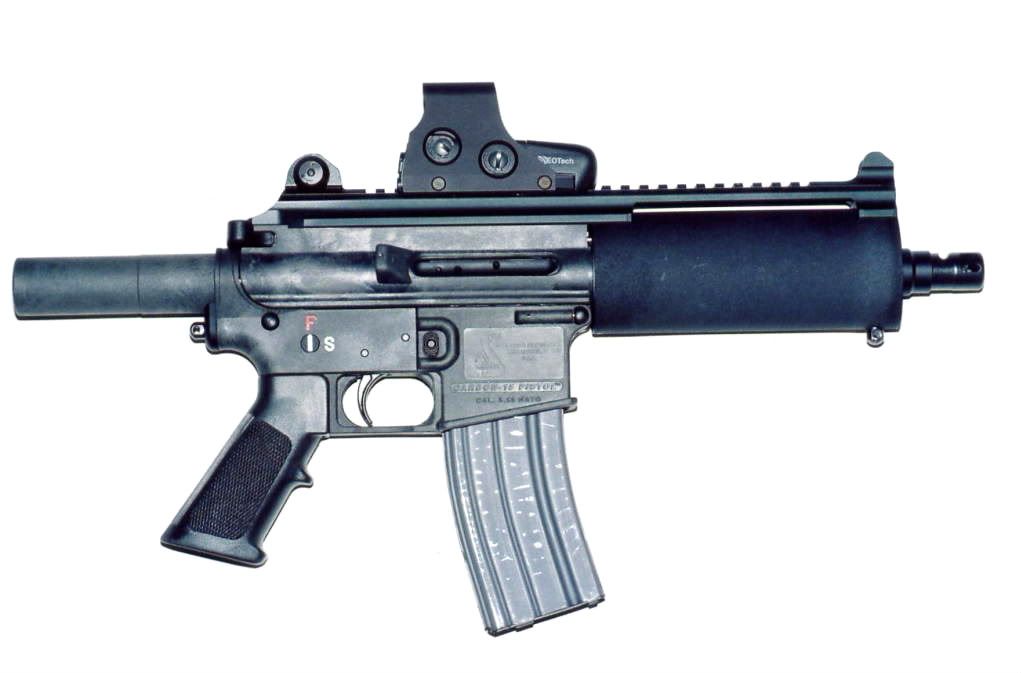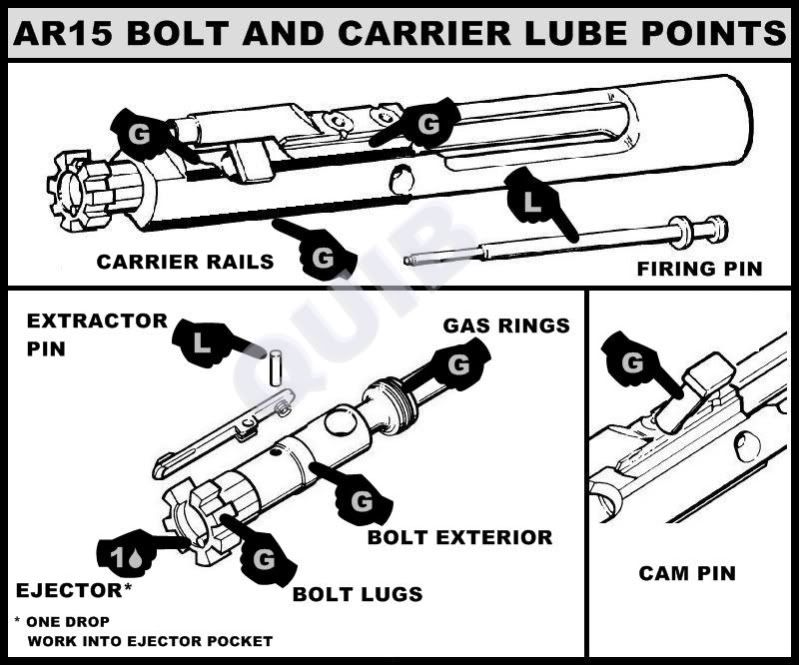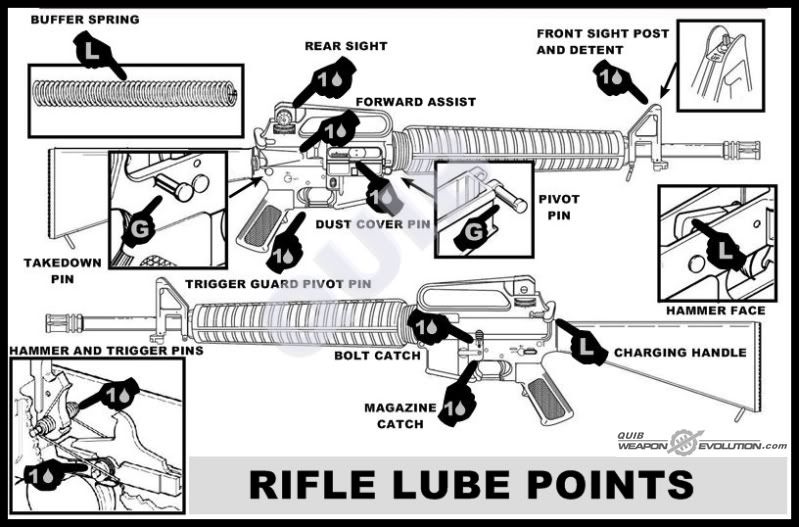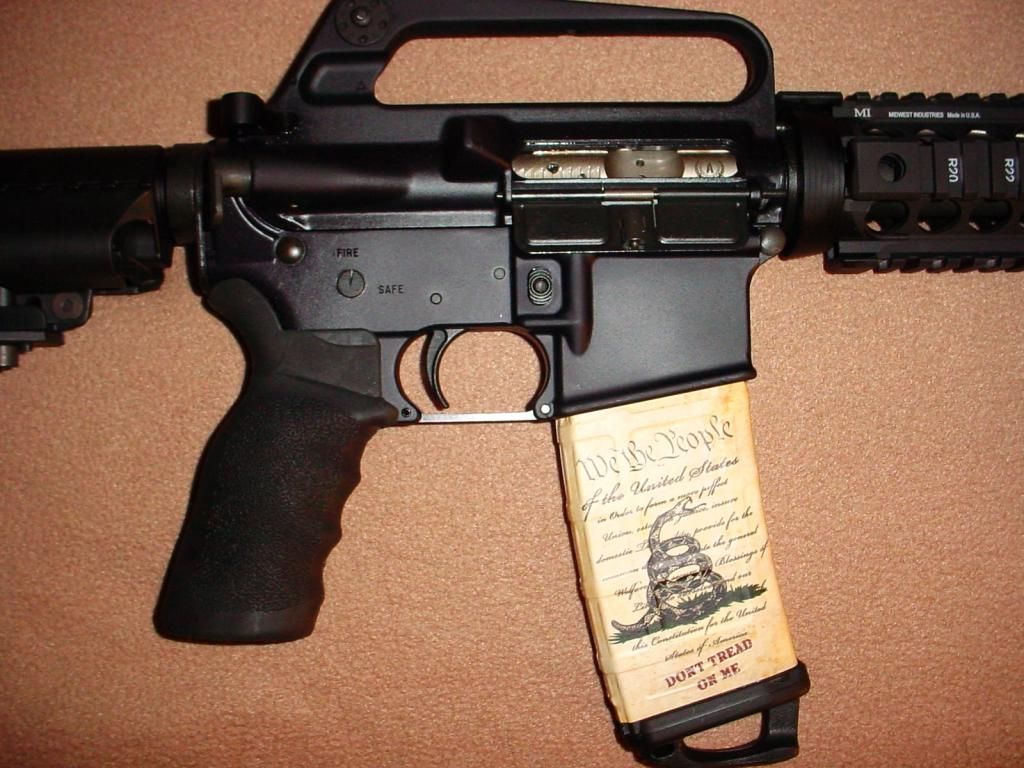You are using an out of date browser. It may not display this or other websites correctly.
You should upgrade or use an alternative browser.
You should upgrade or use an alternative browser.
It's official- I'm now one of the AR collective
- Thread starter The_Eric
- Start date
- Status
- Not open for further replies.
I wouldn't get too hung up on AR-15 receiver material. The fact is there are a lot of Polymer lowers out there, and most of them hold up amazingly well. Some years back Bushmaster produced a series of AR-15 rifles and pistols with a "Carbon 15" lower and upper receivers. They weren't carbon fiber as we now know it. But were made from a carbon slurry that was compression molded and thermally cured in the process. A lot of people badmouthed them on forums and such. But again, they held up very well.
This is a photo of a Bushmaster Carbon 15/21-S Pistol I bought back in 2006. In the last 11 years this gun has seen thousands of rounds of M-193 Ball without so much as a hiccup. It just keeps coming back for more. In the world of shotguns the Benelli Nova is considered to be one of the toughest, most reliable pump guns ever made. It features a Polymer receiver. The receivers in most guns just basically hold everything together, and are not subjected to any great internal stresses themselves.
The point being in all of this, is don't over obsess about the type of Aluminum that's used in your AR-15. Most any currently manufactured will do what they're designed to do, and do it very well. You will have other parts fail, before you ever see a receiver go bad.

This is a photo of a Bushmaster Carbon 15/21-S Pistol I bought back in 2006. In the last 11 years this gun has seen thousands of rounds of M-193 Ball without so much as a hiccup. It just keeps coming back for more. In the world of shotguns the Benelli Nova is considered to be one of the toughest, most reliable pump guns ever made. It features a Polymer receiver. The receivers in most guns just basically hold everything together, and are not subjected to any great internal stresses themselves.
The point being in all of this, is don't over obsess about the type of Aluminum that's used in your AR-15. Most any currently manufactured will do what they're designed to do, and do it very well. You will have other parts fail, before you ever see a receiver go bad.

I just got an E-Mail from Primary Arms. They've got Spikes Tactical stripped T6-7075 forged lowers for just $80.00. Seems like a pretty good deal if anyone's interested. Primary Arms is good to deal with, and they ship fast.
http://www.primaryarms.com/spikes-tactic...933592116057620
http://www.primaryarms.com/spikes-tactic...933592116057620
Some of the newer ones have a tension screw built in that allow for you to tighten the fitment of the lower to the upper. That is a nice feature in my opinion.
Originally Posted By: The_Eric
Sort of. I finally bit the bullet so to speak and bought a lower receiver. It's a Noreen from the local indoor range- it cost like $66.00 so I figured why not??? There was the Noreen, an Anderson and something else. The guy behind the counter opined that the Anderson and whatever the other one was were the same part with different etchings (I believe that) and that they were probably made in China and shipped here to be finished... Turn off! The Noreen was made and machined in Montana (looks physically different) so it seems like a win to me?
I think my first will just be a simple 5.56/.223 direct impingement gun with just the basic parts. However being a noob, is there anything I need to avoid?
Congrats and just know it's addictive when you start building.
There's some good advice in this thread. Gonna second BCM, Palmetto and Primary arms, they are good to deal with from my experiences. I'd KISS on your first build, something basic, you then figure out what you like the more you shoot. JMO.
Sort of. I finally bit the bullet so to speak and bought a lower receiver. It's a Noreen from the local indoor range- it cost like $66.00 so I figured why not??? There was the Noreen, an Anderson and something else. The guy behind the counter opined that the Anderson and whatever the other one was were the same part with different etchings (I believe that) and that they were probably made in China and shipped here to be finished... Turn off! The Noreen was made and machined in Montana (looks physically different) so it seems like a win to me?
I think my first will just be a simple 5.56/.223 direct impingement gun with just the basic parts. However being a noob, is there anything I need to avoid?
Congrats and just know it's addictive when you start building.
There's some good advice in this thread. Gonna second BCM, Palmetto and Primary arms, they are good to deal with from my experiences. I'd KISS on your first build, something basic, you then figure out what you like the more you shoot. JMO.
Well I ordered another lower. This time from a different store run by an ex Sheriff's Deputy- a real decent guy. It was that PSA lower that bubbatime linked to above. In fact, from the same website. He tacked on 5%, as he does for everything, so the total was 63.00.
I'd like to build something similar to an M16 clone for the first one. Maybe iron sights or a simple optic.
For the most part, is a bolt, a bolt? What about the forward assist? I see some have them and some don't...
I'd like to build something similar to an M16 clone for the first one. Maybe iron sights or a simple optic.
For the most part, is a bolt, a bolt? What about the forward assist? I see some have them and some don't...
Originally Posted By: The_Eric
......For the most part, is a bolt, a bolt?....
For the most part, yes. Guys will always argue the importance of things like MPI, and HPT. (Magnetic Particle Inspection & High Pressure Testing). But the fact is even the best bolts can fail based on design. The most likely place is at the very narrow side walls, where the bolt cam pin passes through the shank of the bolt itself. While it's possible to have lugs shear off, I've never seen that on ANY AR-15, except when it was caused by incorrect handloads that were basically overloads. That will wreck any gun.
If the bolt carrier group advertises MPI and HPT great, but I really wouldn't worry about it if it doesn't. Again, these parts are made in mass quantity by a few sources in the industry like Continental Machine & Tool, who are set up to manufacture them, and fill very large orders, and sell to the rest of the industry. I've pulled CMT bolts out of Colt's, as well as Stag Arms guns. There are a LOT of sales going on now with bolt carrier groups. Midway has them on sale now for $75.00.
https://www.midwayusa.com/product/352343...remington-matte
......For the most part, is a bolt, a bolt?....
For the most part, yes. Guys will always argue the importance of things like MPI, and HPT. (Magnetic Particle Inspection & High Pressure Testing). But the fact is even the best bolts can fail based on design. The most likely place is at the very narrow side walls, where the bolt cam pin passes through the shank of the bolt itself. While it's possible to have lugs shear off, I've never seen that on ANY AR-15, except when it was caused by incorrect handloads that were basically overloads. That will wreck any gun.
If the bolt carrier group advertises MPI and HPT great, but I really wouldn't worry about it if it doesn't. Again, these parts are made in mass quantity by a few sources in the industry like Continental Machine & Tool, who are set up to manufacture them, and fill very large orders, and sell to the rest of the industry. I've pulled CMT bolts out of Colt's, as well as Stag Arms guns. There are a LOT of sales going on now with bolt carrier groups. Midway has them on sale now for $75.00.
https://www.midwayusa.com/product/352343...remington-matte
Originally Posted By: The_Eric
Well I ordered another lower. This time from a different store run by an ex Sheriff's Deputy- a real decent guy. It was that PSA lower that bubbatime linked to above. In fact, from the same website. He tacked on 5%, as he does for everything, so the total was 63.00.
I'd like to build something similar to an M16 clone for the first one. Maybe iron sights or a simple optic.
For the most part, is a bolt, a bolt? What about the forward assist? I see some have them and some don't...
PSA lowers are GTG, so you'll be just fine. Personally, I'd get proficient with iron sights before worrying about optics, possibly take a class with them. Too many guys get all geeked out when building their first AR because there's so much out there. Only to find out later, after putting some rounds downrange, that they prefer this accessory or that, or especially, a particular red dot or scope.
Well I ordered another lower. This time from a different store run by an ex Sheriff's Deputy- a real decent guy. It was that PSA lower that bubbatime linked to above. In fact, from the same website. He tacked on 5%, as he does for everything, so the total was 63.00.
I'd like to build something similar to an M16 clone for the first one. Maybe iron sights or a simple optic.
For the most part, is a bolt, a bolt? What about the forward assist? I see some have them and some don't...
PSA lowers are GTG, so you'll be just fine. Personally, I'd get proficient with iron sights before worrying about optics, possibly take a class with them. Too many guys get all geeked out when building their first AR because there's so much out there. Only to find out later, after putting some rounds downrange, that they prefer this accessory or that, or especially, a particular red dot or scope.
Originally Posted By: The_Eric
Where, what type (oil or grease) and how much lube does an AR need? I've heard run 'em wet and I've heard apply sparingly.
At the range, the wetter the better. Especially the Bolt Carrier Group. A direct impingement AR-15 will blow any excess lube out the ejection port with the first magazine full of ammo.
L = LIGHT
1 = DROP
G = GENEROUS


Where, what type (oil or grease) and how much lube does an AR need? I've heard run 'em wet and I've heard apply sparingly.
At the range, the wetter the better. Especially the Bolt Carrier Group. A direct impingement AR-15 will blow any excess lube out the ejection port with the first magazine full of ammo.
L = LIGHT
1 = DROP
G = GENEROUS


Originally Posted By: The_Eric
Where, what type (oil or grease) and how much lube does an AR need? I've heard run 'em wet and I've heard apply sparingly.
Using the above diagram, the high friction areas are the the rear face of the bolt lugs, the gas rings, the cam pin, and the 4 slide rails on the carrier.
Some folks use grease on AR's but I have preferred to stay with thicker viscosity gun oils. A thinner lube will burn off within 300 rounds (or way less). A thicker lube can stay put to about 600-800 rounds or so.
That being said, I always lube the gun right before I shoot it. If its a high round count class, I'll throw a bit of lube on every 300-400 rounds.
Direct impingement runs HOT, so you got to keep this platform lubed. More so than most other platforms. This gun uses more oil than any other non-machine gun that I can think of.
I keep a Magpul oil bottle in my grip, so I always have lube with the gun.

Where, what type (oil or grease) and how much lube does an AR need? I've heard run 'em wet and I've heard apply sparingly.
Using the above diagram, the high friction areas are the the rear face of the bolt lugs, the gas rings, the cam pin, and the 4 slide rails on the carrier.
Some folks use grease on AR's but I have preferred to stay with thicker viscosity gun oils. A thinner lube will burn off within 300 rounds (or way less). A thicker lube can stay put to about 600-800 rounds or so.
That being said, I always lube the gun right before I shoot it. If its a high round count class, I'll throw a bit of lube on every 300-400 rounds.
Direct impingement runs HOT, so you got to keep this platform lubed. More so than most other platforms. This gun uses more oil than any other non-machine gun that I can think of.
I keep a Magpul oil bottle in my grip, so I always have lube with the gun.

Originally Posted By: The_Eric
Where, what type (oil or grease) and how much lube does an AR need? I've heard run 'em wet and I've heard apply sparingly.
Best AR lube in the planet is (subjectively) Slip 2000. One of the premier weapons trainers in the country has an AR he's been using in his classes for years that has tens of thousands of rounds thru it and the ONLY thing they ever do with it is lube it with Slip 2000 EWL
http://www.ar15.com/forums/t_2_138/196990_Filthy_14_is_now_over_40_000_rounds.html
Where, what type (oil or grease) and how much lube does an AR need? I've heard run 'em wet and I've heard apply sparingly.
Best AR lube in the planet is (subjectively) Slip 2000. One of the premier weapons trainers in the country has an AR he's been using in his classes for years that has tens of thousands of rounds thru it and the ONLY thing they ever do with it is lube it with Slip 2000 EWL
http://www.ar15.com/forums/t_2_138/196990_Filthy_14_is_now_over_40_000_rounds.html
Okay, so I have another question guys- Looking at bolts on Palmetto's web site and I see some that are listed as full auto, or M16, or AR15, or lastly, a combination of them. Some specify 5.56mm and some don't. What is that all about?
edit: Primary arms has THIS bolt here. Looks like an absolute steal. Why so cheap? Made in China?
edit: Primary arms has THIS bolt here. Looks like an absolute steal. Why so cheap? Made in China?
Last edited:
Originally Posted By: The_Eric
Okay, so I have another question guys- Looking at bolts on Palmetto's web site and I see some that are listed as full auto, or M16, or AR15, or lastly, a combination of them. Some specify 5.56mm and some don't. What is that all about?
edit: Primary arms has THIS bolt here. Looks like an absolute steal. Why so cheap? Made in China?
There is nothing wrong with that Primary Arms bolt carrier group. It is Nickel Boron Coated. Nickel Boron coating has a natural lubricity to it, which requires much less lubrication. It also does not allow carbon to stick as easily. Nickel Boron bolt carrier groups clean up much easier.
An M-16 bolt carrier group is heavier. They can be identified by the longer and heavier section at the rear of the carrier, when compared to a commercial AR-15 bolt carrier, which has a shorter, less heavy rear section. They are generally considered to be more desirable. I swapped out a standard AR-15 bolt carrier group with this Nickel Boron M-16 bolt carrier group in this Bushmaster. It runs beautifully, and I never touched either the buffer or buffer spring.

Okay, so I have another question guys- Looking at bolts on Palmetto's web site and I see some that are listed as full auto, or M16, or AR15, or lastly, a combination of them. Some specify 5.56mm and some don't. What is that all about?
edit: Primary arms has THIS bolt here. Looks like an absolute steal. Why so cheap? Made in China?
There is nothing wrong with that Primary Arms bolt carrier group. It is Nickel Boron Coated. Nickel Boron coating has a natural lubricity to it, which requires much less lubrication. It also does not allow carbon to stick as easily. Nickel Boron bolt carrier groups clean up much easier.
An M-16 bolt carrier group is heavier. They can be identified by the longer and heavier section at the rear of the carrier, when compared to a commercial AR-15 bolt carrier, which has a shorter, less heavy rear section. They are generally considered to be more desirable. I swapped out a standard AR-15 bolt carrier group with this Nickel Boron M-16 bolt carrier group in this Bushmaster. It runs beautifully, and I never touched either the buffer or buffer spring.

What about the 5.56mm? I understand that many guns will safely chamber and fire both that and .223 but is there a physical difference in the bolt?
It's for questions like this that I'm glad there are forum members who are willing to help. Sometimes browsing will only get you close. Here for instance I can ask a specific question and get a specific answer. So to all of you who have replied so far- thank you. It is appreciated.
It's for questions like this that I'm glad there are forum members who are willing to help. Sometimes browsing will only get you close. Here for instance I can ask a specific question and get a specific answer. So to all of you who have replied so far- thank you. It is appreciated.
Originally Posted By: The_Eric
What about the 5.56mm? I understand that many guns will safely chamber and fire both that and .223 but is there a physical difference in the bolt?
The bolts are identical, because the external dimensions of both the .223 and 5.56 MM case are identical. The difference between the 2 is only the freebore in the chamber itself. Freebore is an area forward of the chamber where the rifling has been removed, to allow the bullet a, "running start" at the rifling. This basically allows higher velocity to be achieved with less chamber pressure.
Some, not all 5.56 brass is a bit thicker in the base area. But there is no difference dimensionally between the two. Freebore has been used successfully for years by Weatherby in their Weatherby Magnum calibers. They are generally known for having the highest velocity for their given bore size and bullet weight. I'm to the point that I no longer segregate my 5.56 MM and .223 brass from each other when I reload. Mostly because there is no reason to. A lot of people say it is "unsafe" to fire 5.56 MM ammunition in a .223 chamber. With that said I have NEVER seen evidence of a .223 rifle being damaged by doing so. I have been doing it for over 45 years, and have never experienced a single negative issue in doing it.
What about the 5.56mm? I understand that many guns will safely chamber and fire both that and .223 but is there a physical difference in the bolt?
The bolts are identical, because the external dimensions of both the .223 and 5.56 MM case are identical. The difference between the 2 is only the freebore in the chamber itself. Freebore is an area forward of the chamber where the rifling has been removed, to allow the bullet a, "running start" at the rifling. This basically allows higher velocity to be achieved with less chamber pressure.
Some, not all 5.56 brass is a bit thicker in the base area. But there is no difference dimensionally between the two. Freebore has been used successfully for years by Weatherby in their Weatherby Magnum calibers. They are generally known for having the highest velocity for their given bore size and bullet weight. I'm to the point that I no longer segregate my 5.56 MM and .223 brass from each other when I reload. Mostly because there is no reason to. A lot of people say it is "unsafe" to fire 5.56 MM ammunition in a .223 chamber. With that said I have NEVER seen evidence of a .223 rifle being damaged by doing so. I have been doing it for over 45 years, and have never experienced a single negative issue in doing it.
- Status
- Not open for further replies.
Similar threads
- Replies
- 9
- Views
- 824
- Replies
- 17
- Views
- 4K
- Replies
- 40
- Views
- 34K
